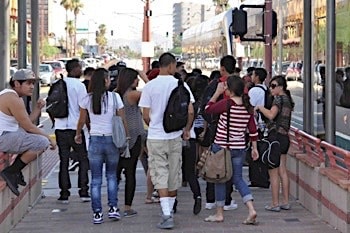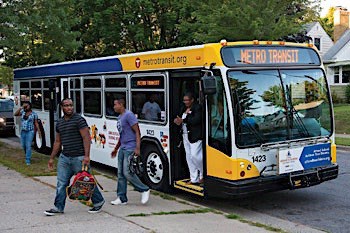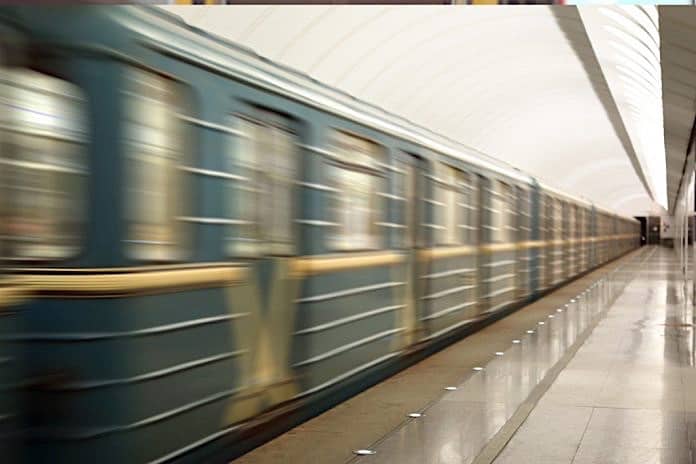 Phoenix Union High School District students have used the city’s buses to get to school for almost four decades. District officials said they have rarely, if ever, complained about financing student transportation as a result.
Phoenix Union High School District students have used the city’s buses to get to school for almost four decades. District officials said they have rarely, if ever, complained about financing student transportation as a result.
Elsewhere, school districts like Seattle, Milwaukee, Chicago, New York and Baltimore are among those that for years have also been using public transit to help students get to and from class. But in a stagnant economy, more school districts are looking to do the same, although skeptics say the jury is still out on just how much money is saved and to what extent children are being jeopardized to realize those savings.
School districts are eliminating bus routes, privatizing services, charging fees and laying off employees to meet dwindling budgets. Still, many districts don’t consider public transit to be an alternative to the yellow school bus but rather an option to their own fleets and those of private contractors. NSTA estimates that a third of the approximately 480,000 school buses in the United States are owned and operated by private bus companies.
Opponents of public transit said school districts should not be so willing to move away from the safety of school buses. They cited bus construction, driver training and the potential for stranger danger as concerns. It is the safety of the younger students that concerns student transporters, said Bob Riley, executive director of NASDPTS.
“Certainly I think students are better off on the yellow school bus because of the bus construction and the fact that drivers are trained to deal specifically with kids,” Riley said. “Transit drivers are not trained to deal with kids, and you don’t know who will be riding with the kids. Conditions on a transit bus are much less controlled from a student’s perspective.”
Attorney Peggy Burns, owner of the Education Compliance Group, said the level of school district liability for students who may be injured, molested or involved in an improper relationship as a result of a contact made on public transit during school hours most likely will be determined by the court.
“The bottom line is that, in most states, a school district likely will be exonerated in the absence of a state law or district policy that prohibits the practice of using public transit to transport regular education students,” she said
Pros and Cons
Public transit works better for high school students because most campuses are located on major thoroughfares or near city bus stops, instead of tucked away in neighborhoods like elementary and middle schools. Still, districts can shy away from contractual agreements with transit companies. Instead, they purchase bus passes and distribute them to qualified students. The advantages can include larger route flexibility, time of use (extracurricular activities) and lower transportation and bus maintenance costs, as districts are only charged a reduced student fee for each ride.
 Public transit also has its vulnerabilities. Labor actions such as strikes can prevent students from getting to school, smart cards can be lost, and students sometimes must take several buses to get to school
Public transit also has its vulnerabilities. Labor actions such as strikes can prevent students from getting to school, smart cards can be lost, and students sometimes must take several buses to get to school
Practice makes perfect, though, and that practice has become so commonplace in Phoenix that it’s difficult to pinpoint when it began. Irene Diaz, the districts’ supervisor of discipline and security, said the partnership dates back to at least 1973. A little more than half of the district’s 26,000 students use the city’s buses and light rail system.
Meanwhile, Milwaukee Public Schools spokesman Mike Turza said the district has been using public transit since the late 1970s. Until about three years ago, 14,000 students used public transit to get to school.
“Now only about 3,500 to 4,000 students are riding county transit,” he said. “We were trying to get a break in price, and we were unsuccessful. So now we use 12 (school bus) contractors. The district does not own any buses. We do the scheduling and manage the contractors.”
The cost, Turza added, is a wash. The county charged the district $575 a year per student and the district’s cost for the yellow bus is about $580 a year per student.
Meanwhile, Phoenix officials said a contracted route costs the district about $5.20 per student per day, whereas public transit costs the district $1.75. The district’s current transportation budget is $13 million. Without public transportation, officials estimate it would skyrocket to $22 million.
“If we transported in-house, we would have to have additional buses, drivers and aides, not to mention the maintenance of the vehicles and gas,” district spokesman Craig Pletenik said. “There are lots of costs we don’t have currently because we use city transportation.”
King County Metro Transit, serving the Seattle area, has been transporting students in Seattle and nearby Bellevue, Wash., for about 15 years.
“The school districts were looking to supplement their yellow bus needs with an emphasis on their high school students,” said Mike Beck, the agency’s school program project manager. “Our focus has really been on the high schools. In Seattle, we transport a small percentage of middle and junior high students.”
As the use of public transit grows, student safety concerns have resurfaced.
“I don’t know how any person who cares for school children can allow them on a transit bus,” said John Benish Jr., chief operating officer for Cook-Illinois Corp., a private contractor in Chicago. “That student could be riding next to a total stranger. There could be 20 other people on that same bus with no background checks and no identification. It’s like opening the school bus and allowing anyone to ride, which is against the law.”
Benish said many older students opt to drive to school or ride city buses because it is the adult thing to do.
“(Riding the school bus) is not a cool, fun way to go to and from school,” he said. “Even with all the regulations, we have to make it a more accepted way to travel to and from school.”
Unfair Competition?
Public transit departments also receive some form of federal and local funding unavailable to private school bus companies. Therefore, the Federal Transit Administration prohibits transit agencies from installing routes to specifically serve students. The federal rule aims to prevent unfair competition. Public transit can, however, treat requests from school districts the same as any other, as long as those same buses remain available to the general public.
The issue was thrust back into the spotlight at the beginning of the current school year, when Minneapolis Public Schools opted to use public transit to transport students to five of its high schools after a successful three-year pilot program. During that first day, school officials, transit employees, volunteers, law enforcement and even the state’s commissioner of education supervised the student riders.
“From all our reports, everything went great,” said spokeswoman Latisha Gray. “We had about 40 or 50 of our staff riding buses on different routes. Student safety and academic achievement are our top priorities. We do not take that lightly.”
In September, school officials in Maryland’s Frederick County School District were asked by County Commissioner Bill Shreve to take a look at using public transit for a more efficient use of the county’s resources.
“We have duplication of routes and we have the capacity on transit buses,” said Shreve. “Transit is financed by county state and federal government. Why not use transit buses? They use city buses in Baltimore.”
Using public funding to compete with private bus companies is the tightrope public transit is walking, student transporters said, and they are crying foul.
“It affects everybody, not just contractors,” Benish said. “Technically, it is not more cost effective because we are paying for it with our taxes. The government is paying for that bus. They are subsidized by the government.”
Reprinted from the November 2012 edition of School Transportation News magazine. All rights reserved.















